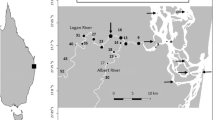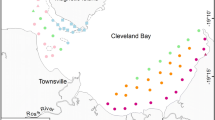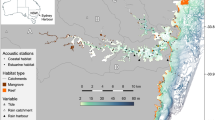Abstract
Innovative telemetry and biologging technology has increased the amount of available movement data on aquatic species. However, real-time information on the environmental factors influencing animal movements can be logistically challenging to obtain, particularly in habitats where tides and currents vary locally. Hydrodynamic models are capable of simulating complex tidal flow, and may thus offer an alternative method of contextualizing animal movement in coastal habitats. Here we use this tool to examine the influence of tide on the movement of broadnose sevengill sharks (Notorynchus cepedianus) in the San Francisco Bay estuary. Three sharks were actively tracked using acoustic transmitters for 3 to 4 days. We then generated a hydrodynamic model of the estuary and calculated current vectors along each track. We hypothesized that the sharks would adjust their swimming speed and direction depending on current strength when passing through the channel underneath the Golden Gate Bridge. Our results indicate that sharks did tend to follow the current flow in the channel, but their overall displacement did not significantly correlate with tidal amplitude. We conclude that the sharks may respond to environmental factors other than tidal flow, altering their movement at a finer scale than initially considered. Overall, this suggests that hydrodynamic simulation models can be used to visualize and quantify environmental factors that may affect movement patterns in aquatic organisms. We recommend future studies combine these models with other biologging techniques to measure energy expenditure at a finer spatial scale.



Similar content being viewed by others
References
Anderson JJ, Beer NW (2009) Oceanic, riverine, and genetic influences on spring Chinook salmon migration timing. Ecol Appl 19(8):1989–2003. https://doi.org/10.1890/08-0477.1
Barnard PL, Jaffe BE, Schoellhamer DH (2013) Preface for special issue of marine geology. Mar Geol 345:1–2
Barnett A, Stevens JD, Frusher SD, Semmens JM (2010a) Seasonal occurrence and population structure of the broadnose sevengill shark Notorynchus cepedianus in coastal habitats of south-East Tasmania. J Fish Biol 77(7):1688–1701
Barnett A, Abrantes K, Stevens JD, Yick JL, Frusher SD, Semmens JM (2010b) Predator-prey relationships and foraging ecology of a marine apex predator with a wide temperate distribution. Mar Ecol Prog Ser 416:189–200
Barnett A, Braccini JM, Awruch CA, Ebert DA (2012) An overview on the role of Hexanchiformes in marine ecosystems: biology, ecology and conservation status of a primitive order of modern sharks. J Fish Biol 80:966–990
Benjamins S, Dale AC, Hastie G, Waggitt JJ, Lea MA, Scott B, Wilson B (2015) Confusion reigns? A review of marine megafauna interactions with tidal-stream environments. Oceanogr Mar Biol 53:1–54
Bennett WA, Kimmerer WJ, Burau JR (2002) Plasticity in vertical migration by native and exotic estuarine fishes in a dynamic low-salinity zone. Limnol Oceanogr 47(5):1496–1507
Bernatchez L, Dodson JJ (1987) Relationship between bioenergetics and behavior in anadromous fish migrations. Can J Fish Aquat Sci 44(2):399–407. https://doi.org/10.1139/f87-049
Borthwick AGL (2016) Marine renewable energy seascape. Engineering 2(1):69–78
Brodersen J, Nilsson PA, Ammitzbøll J, Hansson LA, Skov C, Brönmark C (2008) Optimal swimming speed in head currents and effects on distance movement of winter-migrating fish. PLoS One 3(5):e2156
Brownscombe JW, Cooke SJ, Danylchuk AJ (2017) Spatiotemporal drivers of energy expenditure in a coastal marine fish. Oecologia 183(3):689–699
Chapman JW, Klaassen RHG, Drake VA, Fossette S, Hays GC, Metcalfe JD, Reynolds AM, Reynolds DR, Alerstam T (2011) Animal orientation strategies for movement in flows. Curr Biol 21:861–870
Compagno, LJV (2009) Notorynchus cepedianus. The IUCN red list of threatened species. e.T39324A10200310
Conomos TJ, Smith RE, Gartner JW (1985) Environmental setting of San Francisco Bay. In: Temporal dynamics of an estuary. Springer, Dordrecht, pp 1–12
Deltares Systems (2014) Delft3D-FLOW: simulation of multi-dimensional hydrodynamic flows and transport phenomena, including sediments. Deltares, The Netherlands
Ebert DA (1989) Life history of the sevengill shark, Notorynchus cepedianus Peron, in two northern California bays. Calif Fish Game 75(2):102–112
Ebert DA (1991) Observations on the predatory behaviour of the sevengill shark Notorynchus Cepedianus. Afr J Mar Sci 11(1):455–465
Ebert DA (2003) Sharks, rays, and chimaeras of California. University of California Press, California
Ebert DA, Compagno LJV (2012) FAO species catalogue for fishery purposes. Sharks of the world. An annotated and illustrated catalogue of shark species known to date, vol 1. FAO, Rome
Elias EPL, Hansen JE (2013) Understanding processes controlling sediment transports at the mouth of a highly energetic inlet system (San Francisco Bay, CA). Mar Geol 345:207–220
Elias EPL, Walstra DJR, Roelvink JA, Stive MJF, Klein MD (2001) Hydrodynamic validation of Delft3D with field measurements at Egmond. In: 27th international conference on coastal engineering
Forsythe PS, Scribner KT, Crossman JA, Ragavendran A, Baker EA, Davis C, Smith KK (2012) Environmental and lunar cues are predictive of the timing of river entry and spawning-site arrival in lake sturgeon Acipenser fulvescens. J Fish Biol 81(1):35–53
Gallagher AJ, Creel S, Wilson RP, Cooke SJ (2017) Energy landscapes and the landscape of fear. Trends Ecol Evol 32(2):88–96
Hazen EL, Scales KL, Maxwell SM, Briscoe DK, Welch H, Bograd SJ et al (2018) A dynamic ocean management tool to reduce bycatch and support sustainable fisheries. Sci Adv 4(5):1–8
Kelly JT, Klimley AP (2012) Relating the swimming movements of green sturgeon to the movement of water currents. Environ Biol Fish 93(2):151–167
Ketchum JT, Slager CJ, Buckhorn ML, Nosal AP, Peter Klimley A (2017) Residency and long-distance movements of sevengill sharks (Notorhynchus cepedianus) tagged in San Francisco Bay. Anim Biotelem 5(1):1–9
Klimley APP, Voegeli F, Beavers SSC, Le Boeuf BBJ, Voegell F, Beavers SSC, Le Boeuf BBJ (1998) Automated listening stations for tagged marine fishes. Mar Technol Soc J 32(1):94–101
Last P, Stevens JD (2009) Sharks and rays of Australia, 2nd edn. CSIRO Publishing, Melbourne
Lesser GR, Roelvink JA, van Kester JATM, Stelling GS (2004) Development and validation of a three-dimensional morphological model. Coast Eng J 51(8):883–915
Lieber L, Nimmo-Smith WAM, Waggitt JJ, Kregting L (2018) Fine-scale hydrodynamic metrics underlying predator occupancy patterns in tidal stream environments. Ecol Indic 94:397–408
Nathan R, Getz WM, Revilla E, Holyoak M, Kadmon R, Saltz D, Smouse PE (2008) A movement ecology paradigm for unifying organismal movement research. Proc Natl Acad Sci 105(49):19052–19059
NOAA, National Ocean Service, Center for Operational Oceanographic Products and Services (2019)
Pebesma E, Klus B, Moradi M (2015) Trajectories: classes and methods for trajectory data. R package version 0.2-1
Pierce D (2017) ncdf4: Interface to Unidata netCDF (version 4 or earlier) format data files. R package version 1.16
Pincock DG, Voegeli FA (2002) Quick course in underwater telemetry systems. Vemco Limited
R Core Team (2017). R: A language and environment for statistical computing. Vienna, Austria: R Foundation for Statistical Computing
Roffe TJ, Mate BR (1984) Abundances and feeding habits of pinnipeds in the Rogue River, Oregon. J Wildl Manag 48(4):1262–1274
Shepard ELC, Wilson RP, Rees WG, Grundy E, Lambertucci SA, Vosper SB (2013) Energy landscapes shape animal movement ecology. Am Nat 182(3):298–312
Stasko AB (1975) Progress of migrating Atlantic salmon (Salmo salar) along an estuary, observed by ultrasonic tracking. J Fish Biol 7(3):329–338
Turchin P (1998) Quantitative analysis of movement. Sunderland. In: Massachusetts. Sinauer. Inc, USA
U.S. Geological Survey (2014). San Francisco Bay basic tide model. Accessed February 2017 at https://walrus.wr.usgs.gov/coastal_processes/sfbaycoastalsys/SFBay_model/
Welch H, Hazen EL, Bograd SJ, Jacox MG, Brodie S, Robinson D, Scales KL, Dewitt L, Lewison R (2019) Practical considerations for operationalizing dynamic management tools. J Appl Ecol 56(2):459–469
Whitney, N., White, C., Anderson, P., … R. H.-F., & 2017, U. (2017). The physiological stress response, postrelease behavior, and mortality of blacktip sharks (Carcharhinus limbatus) caught on circle and J-hooks in the Florida recreational fishery. Fish B-NOAA 115(4), 532–543
Wilson RP, Quintana F, Hobson VJ (2012) Construction of energy landscapes can clarify the movement and distribution of foraging animals. Proc R Soc Lond B Biol Sci 279(1730):975–980
Wright BE, Riemer SD, Brown RF, Ougzin AM, Bucklin KA (2007) Assessment of harbor seal predation on adult salmonids in a Pacific Northwest estuary. Ecol Appl 17(2):338–351
Acknowledgements
The authors would like to thank members of the UC Davis Biotelemetry Laboratory for their work in maintaining both the passive and active tracking equipment used in the San Francisco Bay. We also thank Michael Gill for serving as skipper of the Aquarium of the Bay vessel when tagging sharks. We want to recognize Dr. Jonathan Houghton, who provided invaluable guidance in the final stages of this manuscript. We thank the Aquarium of the Bay for providing funding for the study through AOB Foundation. Finally, we are grateful for the contributions of two anonymous reviewers who provided feedback to improve the manuscript.
Funding
Additional support was provided by California Agricultural Experimental Station of the University of California Davis to NAF (CA-D-ASC-2091-H).
Author information
Authors and Affiliations
Contributions
AGM wrote the manuscript, created the hydrodynamic model and performed statistical analyses. AES assisted in writing the manuscript, performing statistical analyses and prepared figures. MLB led the tagging and active tracking of sevengill sharks and contributed to the writing of the manuscript. PTS participated in shipboard tracking and reviewed the manuscript. CJS provided funding, assisted in data collection, and reviewed the manuscript. NF assisted in writing and reviewing the manuscript. APK conceived of the project, secured funding, assisted in data collection, and reviewed the manuscript. DC conceived of and supervised statistical analyses, generated the hydrodynamic model, and assisted in writing and reviewing the manuscript. All authors contributed critically to the drafts and gave final approval for publication.
Corresponding author
Ethics declarations
Ethical approval
The methods pertaining to shark capture, tagging, and release in this study followed a protocol approved by the University of California, Davis Institutional Animal Care and Use Committee (Protocol 06–12,892). Sharks were collected under a California Department of Fish and Wildlife Scientific Collecting Permit (SC-3224). Transmitters were inserted by researchers practiced in the appropriate surgical technique, animal stress was monitored throughout the procedure, and handling time from capture to release was minimized.
Competing interests
The authors declare no competing interests.
Additional information
Publisher’s note
Springer Nature remains neutral with regard to jurisdictional claims in published maps and institutional affiliations.
Rights and permissions
About this article
Cite this article
McInturf, A.G., Steel, A.E., Buckhorn, M. et al. Use of a hydrodynamic model to examine behavioral response of broadnose sevengill sharks (Notorynchus cepedianus) to estuarine tidal flow. Environ Biol Fish 102, 1149–1159 (2019). https://doi.org/10.1007/s10641-019-00894-3
Received:
Accepted:
Published:
Issue Date:
DOI: https://doi.org/10.1007/s10641-019-00894-3




